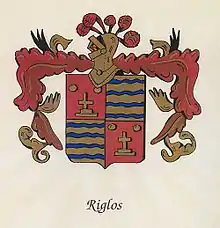Miguel de Riglos Bástida
Miguel de Riglos y de la Bastida (1649-1719) was a Spanish military, politician and merchant, who served during the Viceroyalty of Peru as alcalde of Buenos Aires.[2]
Miguel de Riglos y Bástida | |
|---|---|
 | |
| Vice-Mayor of Buenos Aires | |
| In office 1708–1709 | |
| Monarch | Philip V of Spain |
| Preceded by | ? |
| Succeeded by | Francisco de Tagle Bracho |
| Vice-Mayor of Buenos Aires | |
| In office 1682–1683 | |
| Monarch | Charles II of Spain |
| Preceded by | Juan de San Martín |
| Succeeded by | Luis Naharro de la Madrid |
| Personal details | |
| Born | May 5, 1649 Tudela, Navarre, Spain |
| Died | August 6, 1719 Buenos Aires, Viceroyalty of Peru |
| Nationality | Spanish |
| Spouse(s) | Gregoria Silveyra Gouvea (1673-1707) María Leocadia de Torres Gaete (1709-1710) Josefa Rosa Alvarado Terra.[1] |
| Occupation | politician merchant army |
| Profession | Army officer |
| Signature |  |
| Military service | |
| Allegiance | |
| Branch/service | Spanish Army |
| Years of service | c.1669-1700 |
| Rank | General |
| Unit | Fuerte de Buenos Aires |
Biography
He was born in Tudela, Navarre, the son of Juan de Riglos and Fermina de la Bastida, belonging to a noble family of Aragonese roots.[3] He arrived in the Río de la Plata from Cádiz in 1670, aboard the ship "San Hermenegildo".[4]
Riglos was one of the richest men in the Río de la Plata to early 18th century. Installed in Buenos Aires he dedicated himself to the trade and import of leather, being in charge of the business of cimarron cattle of Buenos Aires Province.[5] He had among his possessions a luxurious carriage with golden studs, and a stained glass window inside.[6] He also built a luxurious house known as the "Altos de Riglos", the first house on two floors of Buenos Aires,[7] located at the current corner Bolivar and Avenida Rivadavia, neighborhood Monserrat.[8]
Riglos also owned a sumptuous residence (la Mesón del Retiro) in the Retiro area. This residence was rented in 1703 to the Compagnie Royale de Guinée, a French "company" that had operated in Buenos Aires until 1712.[9] Years later in 1718 Riglos sold his property to Thomas Dover, president of the South Sea Company in Buenos Aires.[10]
"La Casa del Retiro" was located in the current Plaza San Martín, and his first owner was the Governor of Buenos Aires Don Agustín de Robles Lorenzana, who had sold it to Miguel de Riglos around 1700.[11]
In addition to having served as commander of the Fort of Buenos Aires, he held honorary offices in the city of Buenos Aires, serving as regidor[12] and mayor of second vote in 1682 and 1708.[13]
Miguel de Riglos was the ancestor of María de los Remedios de Escalada, the wife of General don José de San Martín.[14] His grandson Miguel Fermín de Riglos was a knight of the Order of Santiago.[15]
References
- Los americanos en las órdenes nobiliarias (1529-1900), Guillermo Lohmann Villena, 1947
- Tradiciones de Buenos Aires: sér., 1580, Pastor Servando Obligado, 1900
- Caballeros de la Orden de Santiago: continuacion de la obra de Vicente de, Emilio de Cárdenas Piera, 1977, ISBN 9788487204692
- Calvo, Carlos (1939), Nobiliario del antiguo virreynato del Río de la Plata ...
- Cómo era Buenos Aires, Fermín Vicente Arenas Luque, 1979
- Historia social y cultural del Río de la Plata, 1536-1810: el trasplante social, Guillermo Fúrlong Cárdiff, 1969
- Historia, Números 9-12, 1957, 1957
- Historia cultural de los argentinos: Del período prehispánico a la época de Rosas, José Luis Cosmelli Ibáñez, 1975
- Historia, Volume 2, Issues 5-8, Armando Alonso Piñeiro, 1982
- Saavedra, el hombre de Mayo, Ediciones Culturales Argentinas, Ministerio de Cultura y Educación, Secretaría de Estado de Cultura, 1980
- Historia, Volumes 11-14, Argentina, 1958
- Apogeo y ocaso de los Anchorena, Juan José Sebreli, 1972
- Registro estadístico de la provincia de Buenos Aires, Parts 1-2, Buenos Aires (Argentina : Province). Oficina de Estadística General
- La sociedad de Buenos Aires en sus derechos a mayorazgos y a otras fundaciones españolas: (siglo XVII), Jorge A. Serrano Redonnet
- Caballeros de la Orden de Santiago: Siglo XVIII.. Índice onomástico (, Caballeros de la Orden de Santiago: Siglo XVIII.. Índice onomástico (